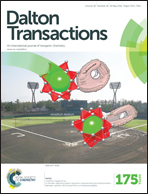The influence of different coordination environments on one-dimensional Cu(ii) coordination polymers for the photo-degradation of organic dyes†
Abstract
Three new Cu(II) coordination polymers, namely, {[Cu3(L1)(NO3)2(DMF)(H2O)]·3(DMF)}n (1), [Cu3(L1)(Cl)2(DMF)2]n (2) and [Cu3(L2)(NO3)4(H2O)4]n (3), were synthesized from pyridine-2,6-dicarbohydrazide based imine linked tritopic ligands. All the complexes were characterized using elemental analysis, IR, UV–vis spectroscopy and ESI-MS. The solid state structures of complexes 1–3 were determined using single crystal X-ray crystallography. The complexes contain trinuclear copper units connected through different anions that lead to the formation of one dimensional (ID) chain structures. Depending upon the anion of the copper salt and donor atoms of the ligands used in complexation, a small variation in the structures was observed. In complex 1, the trinuclear copper units are connected by phenoxo-bridging (μ2-O−) along with one coordinated water molecule, whereas complex 2 is connected through chloride bridging (μ2-Cl) and complex 3 is connected through nitrate ions (μ-[O–N–O]) along with four water molecules. Photo-catalytic activities of the synthesized complexes (1–3) were investigated. All the complexes were found to be photo-catalytically active; however, the distinct coordination environment of the metal ions (i.e. difference in the coordinated water molecules and donor sites of ligands) played a significant role in the catalytic activities. Therefore, this study presents comparative photo-catalytic studies of different coordination environments of metal ions in one-dimensional Cu(II) coordination polymers. The results provide a potential pathway for the rational design of more efficient photo-catalysts.


 Please wait while we load your content...
Please wait while we load your content...